I never figured that out. Why do we have 220 ohm and 470 ohm, rather than 100 ohm, 200 ohm, 300 ohm?
Any particular reason? maybe it's just legacy from old manufacturing process.
I never figured that out. Why do we have 220 ohm and 470 ohm, rather than 100 ohm, 200 ohm, 300 ohm?
Any particular reason? maybe it's just legacy from old manufacturing process.
Resistor values are arranged so that adjacent values are in an (approximately) constant ratio.
Resistors are arranged in series with N values per decade.
Standard series are eg E12 with 12 values per decade, E24 with 24 ... E96 ...
The values area arranged so the RATIO between adjacent values is about the same, so that
$$ R_{n+1} = k R_n$$
Follow this thought to its logical conclusion and you see that for an EXX series, eg E12 so XX = 12, then for 12 equally space ratio resistors per decade the difference k is the xx'th root of 10.
$$k = 10^{(1/XX)}$$
so eg for the E12 series with 12 values between 1 and 10 Ohms or 10k and 100k, then
$$K= 10^{1/12} \approx 1.212 $$
So to get 12 values from 1 to 10 the values would be $$ 1.212^0 = 1.000 \\ 1.212^1 = 1.212 \\ 1.212^2 = 1.479 \\ 1.212^3 = 1.780 \\ ... $$ Yielding E12 value:
1 1.212 1.2
2 1.468944 1.5
3 1.780360128 1.8
4 2.157796475 2.2
5 2.615249328 2.7
6 3.169682185 3.3
7 3.841654809 3.9
8 4.656085628 4.7
9 5.643175781 5.6
10 6.839529047 6.8
11 8.289509205 8.2
12 10.04688516 10.0
There is slight disagreement with the std value in a few cases.
eg 3.169... -> 3.3
8.28945 ... -> 8.2
but the basis is clear.
The same method applies for other series so eg the E96 series values are spaced by $$ k = 10^{(1/96)} $$
An extremely useful consequence of this attribute is that
if two resistors N positions apart in a series have a certain ratio
then ALL resistor pairs N positions apart have the same ratio.
eg to get a 1.5: 1 ratio we can use 1.5K and 1K.
1.5K : 1K = 1.5:1
BUT in the series 1, 1.2, 1.5, 1.8 - the values 1.0 and 1.5 are two positions apart. So, any two resistors 2 positions apart will have a ratio of about 1.5:1 in value.
so eg 2.7 / 1.8 = 1.5,
and 6.8 / 4.7 = 1.447 ~= 1.5 etc.
In electronics, international standard IEC 60063 defines preferred number series for resistors, capacitors, inductors and Zener diodes. It works similarly to the Renard series, except that it subdivides the interval from 1 to 10 into 6, 12, 24, etc. steps. These subdivisions ensure that when some arbitrary value is replaced with the nearest preferred number, the maximum relative error will be on the order of 20%, 10%, 5%, etc.
Copied from wiki E series

Resistors are built such that the increments between values make sense for the range of resistance in question. For example, for low value resistors you might want 1 ohm and 2 ohm values, but for a 1 Meg resistor you wouldn't want 1,000,002 ohms to be the next value. In order to make this work out, the decades are divided into a reasonable number of values per decade to acheive a given accuracy. So for example for E96 (96 values per decade, 1% tolerance) each value is given by 10^(n/96) rounded to 2 decimal places and multiplied by the appropriate power of 10 for the decade in question. (Where n is an integer representing the nth resistor in the series.)